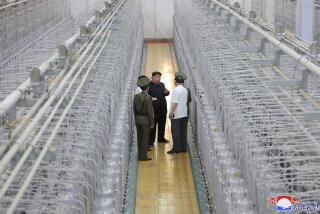Nuclear-Waste Blast Revives Russian Fears
- Share via
MOSCOW — Russian officials said Wednesday that although the explosion in a vat of atomic waste at a secret Siberian complex could be considered the country’s worst nuclear accident since Chernobyl, it was tiny in comparison.
“You simply cannot liken it to Chernobyl,” Nuclear Energy Ministry spokesman Georgy Kaurov told reporters. “About 80 million curies of radioactivity were released at Chernobyl. Here, we do not have even a single curie. So it is 80 million times less.”
The officials said there have been no casualties from the accident Tuesday and little damage.
Despite its apparently limited scope, the accident struck a deep chord of anxiety in a country that remembers well the horrors of the 1986 explosion and fire at the Chernobyl nuclear reactor, which sent clouds of radioactive gas and dust across Ukraine, Belarus, Russia and parts of Europe. Official estimates put the Chernobyl death toll at 32, but scientists believe the disaster led to the deaths of thousands more.
“The incident at Tomsk-7 is a warning: The nuclear monster of the former Soviet Union is seriously ill,” the daily newspaper Izvestia declared.
State television reported with some trepidation Wednesday night that air-defense units had detected a cloud of radiation released Tuesday from the Tomsk-7 plutonium reprocessing plant when pressure suddenly built up in a tank containing nuclear waste, blowing off its top and part of the building’s roof. Tomsk-7 is so secret that it does not appear on most maps.
Reports varied on exactly how far radiation had spread from the leak. Officials said the radiation had been picked up by wind blowing away from the nearby city of Tomsk and left a tongue of lightly contaminated land about 77 square miles in area. Greenpeace environmental activists in Moscow said the radioactive cloud was moving east past Asino toward the Yenisey River.
Soldiers worked Tuesday night and into Wednesday to collect or decontaminate the soil and snow.
The plant’s director said that only one worker, a fireman putting out the flames that followed the vat’s eruption, received an even slightly dangerous dose of radiation--and that dose amounted to one-tenth of the annual exposure allowed workers at the plant.
“What happened was an extremely unpleasant incident that fortunately carried no serious consequences either for people or for nature,” director Gennady Khandorin told Izvestia. He said workers had not been evacuated from the plant.
Residents of Tomsk, about 1,800 miles east of Moscow, said by phone that they are unconcerned both about their own city and Tomsk-7 nearby.
“Why should we evacuate children from there? The level of radiation there is the same as I have in my office,” said a Tomsk police officer on duty Wednesday night.
In one sense, the Tomsk-7 accident was heartening: The official response to it showed just how far the Russian attitude on informing the public during a nuclear incident has come.
After the Chernobyl accident, authorities did not let people know for three days that there had been a dangerous radiation release, depriving them of the chance to take such elementary precautions as swallowing iodine drops. In contrast, Tomsk officials said they went on the radio with news of the accident within an hour after it occurred.
But more than anything, Tuesday’s incident served as a reminder that the Soviet record of carelessness with nuclear facilities continues to this day, and could worsen as Russia sinks further into economic decline.
The Soviet Union had the world’s first major nuclear accident in 1957 when a load of highly radioactive waste exploded at the Mayak complex near Chelyabinsk, expelling fallout packing 2 million curies of radioactivity into the air. That same complex has contaminated about 11,000 square miles with atomic waste.
For several decades, the Soviet Union freely dumped used reactors and nuclear waste into its oceans and set off more than 100 “peaceful nuclear explosions” for everything from mining to oil extraction.
Several nuclear submarines sank to radioactive graves, and 343 underground nuclear explosions at the Semipalatinsk test site in Kazakhstan have led residents to believe their homeland is fouled for good. In some places, ecological officials say, the contamination will indeed remain for all time.
Most recently, in March, 1992, a valve on a Chernobyl-type reactor at a plant outside St. Petersburg failed, and a tube holding 400 pounds of uranium burst and spewed radioactive steam into the air, renewing worries about Russian nuclear safety.
And an accident at Tomsk-7 in 1990 is believed to have contaminated a nearby river and injured 38 people.
The latest Tomsk-7 accident occurred not in a nuclear reactor but at a facility for separating plutonium--a plant that until recently was reportedly used to produce weapons-grade material for the Soviet nuclear arsenal and now processes used nuclear fuel from power plants.
Greenpeace environmental activists said the Tomsk-7 incident highlights the dangers of Russia’s plans to expand factories for processing nuclear waste to produce plutonium.
“The plutonium plants at Tomsk, Chelyabinsk and Krasnoyarsk must be shut down,” Dmitri Tolmatsky of Greenpeace Russia said in a news release. “It is madness for the Russian government to continue to separate plutonium in these secret plants held over from the Cold War. We are already awash in plutonium.”
It was not clear exactly why the explosion occurred, whether from human error or an unpredictable chemical reaction. Plant director Khandorin said that in a 1,200-cubic-foot tank, “for reasons yet to be ascertained,” the pressure shot up so fast that it destroyed the tank within six minutes.
The pressure rose after nitric acid had been added to the tank as a cleanser. The explosion shorted part of the plant’s electrical system, setting off a fire that was quickly put out.
Officials said the contaminated area included a tiny village of 20 people, where the radiation level was too low for danger, as well as the plant’s industrial zone, woods and part of a highway.
The zone’s overall radiation level was put at 0.04 roentgens an hour. For comparison, an acceptable dose for nuclear workers is 2 roentgens a year.
Russia’s Nuclear Scare
Russia said the radiation leak at a plutonium reprocessing plant caused only minor contamination and no casualties.
What Happened: Nitric acid was added as a cleanser to a tank containing uranium and liquid wastes, causing it to explode.
The Damage: A reinforced concrete lid blew through the plant’s roof, starting a fire.
The Radioactive Cloud: On Wednesday, the cloud passed Asino, a town of about 30,000 moving northeast at 22 m.p.h.
More to Read
Sign up for Essential California
The most important California stories and recommendations in your inbox every morning.
You may occasionally receive promotional content from the Los Angeles Times.













